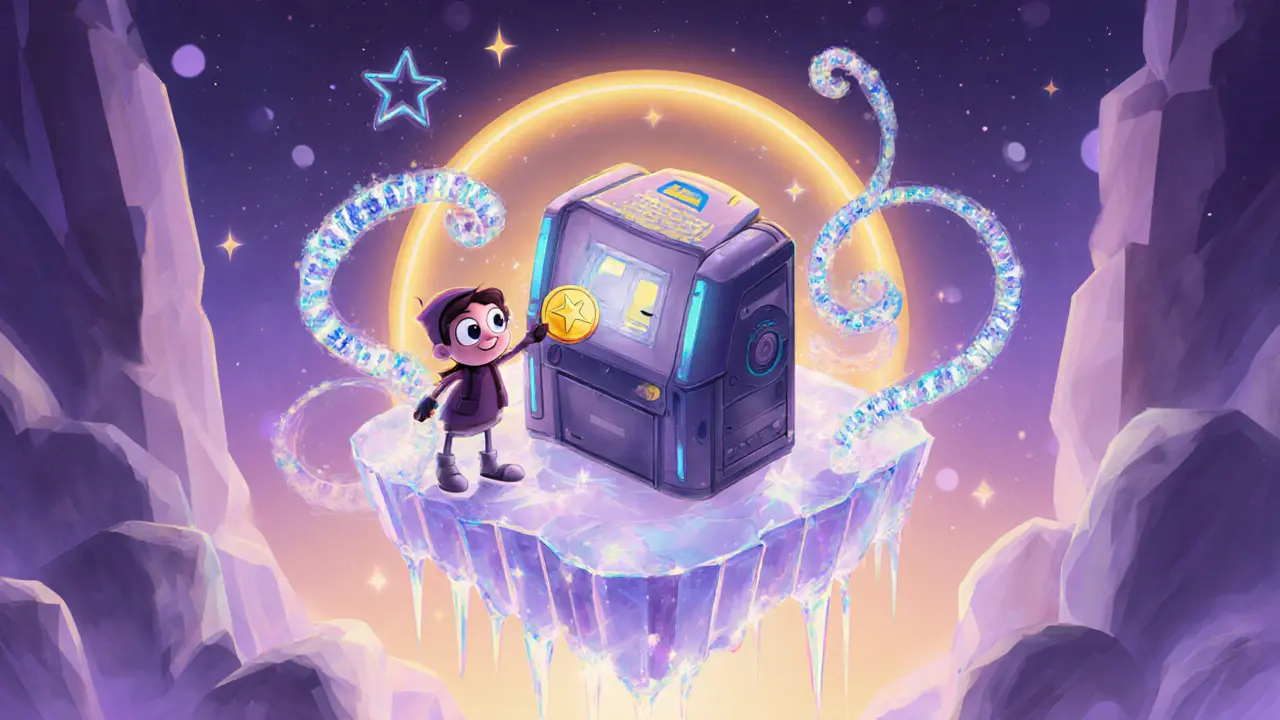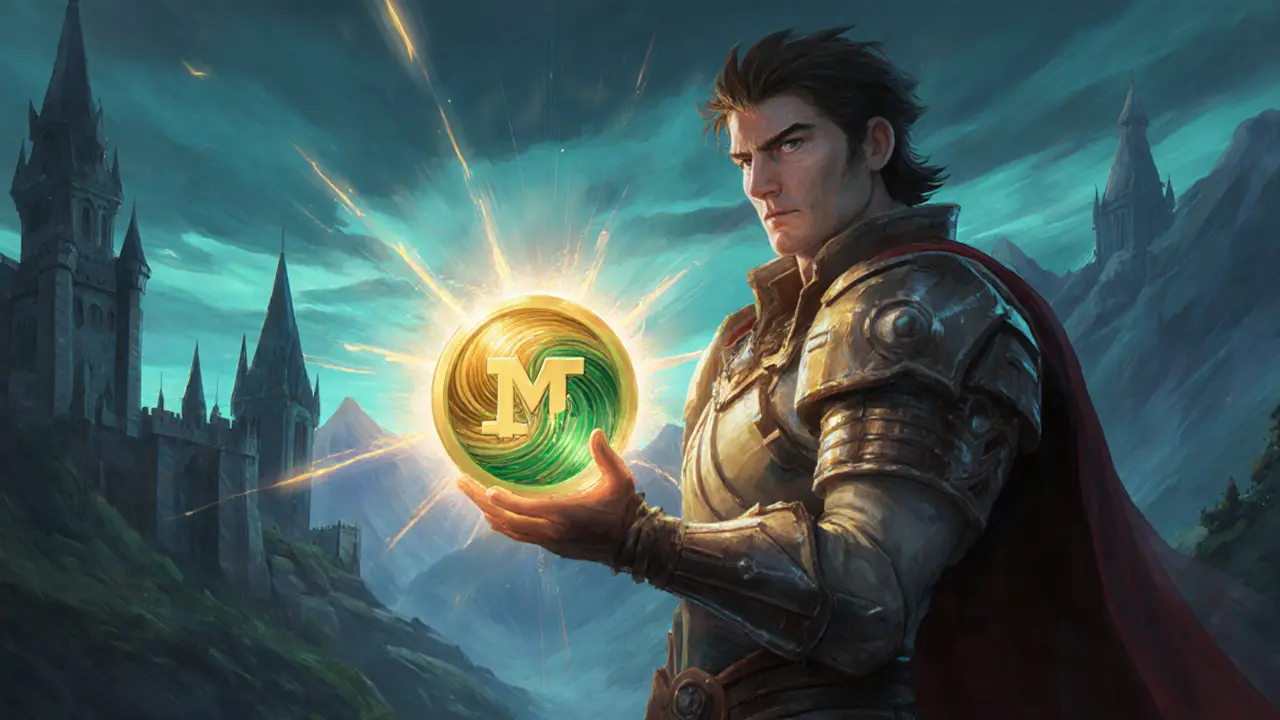Immortal Token (IMT) Converter
Current Token Status
Total Supply
1,000,000,000 IMT
Circulating Supply
~180,000,000 IMT
Current Price
$0.00438 USD
Network
Immutable zkEVM
Token Conversion Calculator
Convert IMT to Starlight and Stardust. Note: Stardust conversions are irreversible.
Conversion Successful!
Tokenomics Overview
| Allocation | Percentage | Description |
|---|---|---|
| Contributor Rewards | 55% | Ecosystem operations, staking incentives |
| Team Vesting | 20% | Founding team, 4-year vesting |
| Partnerships & Liquidity | 15% | Strategic partnerships, liquidity |
| Community & Marketing | 10% | Grants, NFT minting, marketing |
Ever wondered how a cryptocurrency can be more than just a trading asset and actually power a video game? Immortal Token does exactly that - it’s the native token behind the dark‑fantasy Web3 RPG Immortal Rising 2. Launched in late 2024, IMT bridges on‑chain governance, in‑game economies, and real‑world market dynamics. This guide breaks down what IMT is, how you can use it, and what to watch out for before you dive in.
Quick Facts
- Launch: September2024 (mainnet on Immutable zkEVM)
- Total supply: 1billion tokens (fixed)
- Circulating supply (Oct2025): ~180million (≈18%)
- Current price: $0.00438 USD per token
- Key utilities: governance voting, conversion to Starlight and Stardust, staking, NFT purchases
What Is Immortal Token?
Immortal Token (tickerIMT) is a gaming‑focused cryptocurrency that serves as the governance and utility token for Immortal Rising 2. Players-called Immortals-battle demons, complete quests, and earn rewards that are directly tied to on‑chain assets. Holding IMT lets you vote on game‑balance changes, reward structures, and future feature roll‑outs, turning the community into a co‑developer.
Tokenomics & Supply Structure
The tokenomics are deliberately simple. A hard‑cap of 1billion IMT ensures no hidden inflation. Tokens are allocated as follows:
- 55% for contributor rewards, ecosystem operations, and staking incentives.
- 20% reserved for the founding team, released on a 4‑year vesting schedule.
- 15% for strategic partnerships and liquidity provisioning.
- 10% for community grants, NFT minting, and marketing.
Only about 18% is in circulation, which helps keep short‑term price pressure low. The vesting schedule aligns the team’s interests with long‑term growth, a point frequently highlighted by analysts.
How IMT Powers Immortal Rising 2
The game runs a dual‑currency model:
- Starlight - a high‑value token used for governance votes, NFT creation, and premium in‑game items.
- Stardust - the everyday spendable currency for weapons, armor, and consumables.
Players can convert IMT to Starlight at a rate set by the foundation, then swap Starlight 1:1 for Stardust. Conversions from Stardust back to any crypto are irreversible, encouraging thoughtful use.
Technical Foundation: Immutable zkEVM
IMT lives on Immutable zkEVM, an Ethereum Layer‑2 solution that uses zk‑rollups. This offers three big benefits for gamers:
- Transaction fees drop from several dollars on mainnet Ethereum to fractions of a cent.
- Throughput scales to thousands of transactions per second, so thousands of players can claim rewards simultaneously.
- Security inherits Ethereum’s decentralisation, protecting assets from typical L2 exploits.
In practice, a player finishing a dungeon can receive a Starlight reward and have it recorded on‑chain in under two seconds-a speed that feels native to modern games.

Governance, Staking, and Play‑to‑Earn
Holding IMT does more than grant voting rights. The ecosystem encourages a play‑to‑earn loop:
- Complete PvE or PvP challenges → earn Starlight.
- Convert Starlight → Stardust for gear, or back to IMT for market trading.
- Stake IMT (or Starlight) → earn additional tokens proportional to network participation.
- Vote with staked tokens → influence future reward formulas, creating a feedback loop where active voters shape more lucrative earn opportunities.
Governance proposals are posted on the game’s Discord and official forum; token holders submit votes directly through their connected wallet. The result is a transparent “player‑first” development model.
Risks & Considerations
While the concept is compelling, there are concrete risks:
- Regulatory fragmentation: The Korean version of the game disables token features, hinting at future jurisdictional hurdles.
- Supply data opacity: Circulating supply numbers are self‑reported, lacking third‑party verification.
- Irreversible conversions: New players may mistakenly convert IMT to Stardust, losing the ability to re‑enter the governance loop.
- Game adoption dependency: The token’s utility hinges on sustained player growth; a drop in active users could depress value.
Balancing speculation with genuine in‑game utility will be the ecosystem’s make‑or‑break factor.
Future Outlook
Analysts see three main drivers for IMT’s next phase:
- Content updates: New chapters, raids, and NFT‑based hero skins will expand token demand.
- Cross‑game integrations: Plans to allow Starlight or Stardust to be used in partner Web3 titles could broaden the user base.
- Institutional interest: As GameFi gains credibility, fund managers are eyeing projects with real‑world utility-IMT fits that bill if the player count hits the projected 500k active users.
Keeping an eye on governance participation rates, conversion metrics, and monthly active users will give the clearest picture of long‑term health.
Comparison with Typical Gaming Tokens
| Feature | Immortal Token (IMT) | Typical Gaming Token |
|---|---|---|
| Primary Use | Governance + Dual in‑game currencies | Usually only in‑game purchases |
| Layer‑2 Scaling | Immutable zkEVM (sub‑cent fees) | Often Ethereum mainnet (high fees) |
| Supply Transparency | Hard cap 1B, 4‑year vesting | Varies; many lack vesting schedules |
| Staking Rewards | Earn extra IMT/Starlight for participation | Rarely offered |
| NFT Integration | Directly mints hero/gear NFTs | Often separate marketplace |
Getting Started: A Step‑by‑Step Checklist
- Install a compatible wallet (e.g., MetaMask set to Immutable zkEVM).
- Buy IMT on one of the 16 listed exchanges and transfer to your wallet.
- Connect your wallet to the Immortal Rising 2 portal.
- Stake IMT or convert to Starlight to unlock governance voting.
- Play the game, earn Starlight, and decide whether to convert to Stardust or keep the governance token.
- Participate in community polls to shape upcoming updates.
Following these steps ensures you’re not just a token holder but an active participant in the game’s evolution.
Frequently Asked Questions
What blockchain does Immortal Token run on?
Immutable zkEVM, a Layer‑2 solution built on Ethereum that uses zk‑rollups for low fees and high throughput.
How can I earn IMT without buying it?
Play Immortal Rising 2, complete quests, and earn Starlight. You can then convert Starlight back to IMT during designated conversion windows.
Is staking IMT risky?
Staking carries typical crypto risks - smart‑contract bugs and market volatility. However, the protocol’s audits and the 4‑year vesting schedule reduce the chance of sudden token dumps.
Can I use IMT on other games?
Currently IMT is tied to Immortal Rising 2, but the team has announced plans for cross‑game collaborations that could extend utility to partner titles.
What happens if I convert IMT to Stardust?
The conversion is irreversible. Stardust can be spent in‑game but cannot be swapped back to IMT or Starlight, so only convert what you’re sure you’ll use for purchases.


Nathan Blades
December 23, 2024 AT 17:37IMT looks like a wild ride, but the tokenomics could actually power some cool games.
Somesh Nikam
January 5, 2025 AT 07:37Reading through the IMT overview was surprisingly refreshing. The allocation split feels thoughtful, especially the heavy weighting toward contributor rewards. If the staking incentives hold up, we might see genuine utility emerge. Keep your eyes on the vesting schedule, and stay patient – good things take time 🙂.
Jan B.
January 17, 2025 AT 21:37IMT's supply stats are clearly laid out. The 55% for rewards seems reasonable.
MARLIN RIVERA
January 30, 2025 AT 11:37Another overhyped meme token trying to ride the GameFi wave. The irreversible Stardust conversion is a gimmick that will likely bite investors.
Jayne McCann
February 12, 2025 AT 01:37Everyone’s cheering for IMT, but I think the hype will die fast.
Richard Herman
February 24, 2025 AT 15:37From a global perspective, IMT brings an interesting blend of zkEVM tech and gaming incentives. While the tokenomics look solid on paper, real adoption will depend on actual game launches. Let’s hope the team can deliver the promised experiences.
Parker Dixon
March 9, 2025 AT 05:37The Immortal Token project tries to meld blockchain tech with gaming, a space that’s been flooded with ambitious promises lately.
Its use of an immutable zkEVM network gives it a solid technical foundation, especially for low‑fee transactions.
The tokenomics, with 55% allocated to contributor rewards, indicate a focus on incentivizing players and developers alike.
However, the 20% team vesting over four years raises questions about long‑term commitment versus short‑term cash‑out risk.
The conversion mechanic to Starlight and Stardust is clever, yet the irreversible nature of Stardust could trap users who act impulsively.
Looking at the circulating supply-about 180 million out of a billion-the token is still relatively scarce, which might support price growth if demand rises.
On the flip side, the current price of $0.00438 suggests that a lot of buying pressure is needed to move the needle.
Community‑driven marketing, as reflected in the 10% allocation, can be a double‑edged sword; it fuels organic growth but also depends heavily on hype cycles.
Partnerships and liquidity at 15% could bring strategic alliances, but without transparent roadmaps those partnerships remain vague.
From a gamer’s standpoint, the real test will be whether any titles actually integrate IMT for in‑game economies.
If developers adopt the token for staking rewards or item purchases, we could see a sustainable utility loop.
Conversely, if the token remains a speculative asset with no real gameplay hooks, it may suffer the same fate as many other GameFi tokens.
The risk alerts in the UI are a nice touch, reminding users that irreversible actions exist-something many projects hide.
Overall, the project balances promise with palpable risk, and the community should stay informed while keeping expectations grounded.
In short, treat IMT like any high‑risk crypto: do your own research, diversify, and never invest more than you can afford to lose.
Stefano Benny
March 21, 2025 AT 19:37IMT’s tokenomics are a textbook case of liquidity‑first design, but the underlying utility stack is still MVP‑grade. The staking‑as‑a‑service model sounds slick, yet without a live metaverse integration it’s just a token‑gated loyalty program. 🚀
Bobby Ferew
April 3, 2025 AT 10:37Oh great, another “groundbreaking” token that promises the moon while the community quietly watches the price tank. The irreversible Stardust conversion feels like a hidden trap, but hey, who needs transparency when you have hype?
celester Johnson
April 16, 2025 AT 00:37One could argue that IMT embodies the very paradox of modern finance: a digital artifact seeking meaning through external validation. Yet, without concrete gameplay integration, it remains a philosophical exercise rather than a functional economy.
Prince Chaudhary
April 28, 2025 AT 14:37Stay focused on the fundamentals: token distribution, vesting schedules, and real‑world use cases. If the team sticks to its roadmap, there’s potential for steady growth.
Sophie Sturdevant
May 11, 2025 AT 04:37Honestly, the hype around IMT is justified – the devs are dropping utility tokens faster than you can say “NFT mint”. If you’re not on board, you’ll miss the next wave.
katie littlewood
May 23, 2025 AT 18:37I love how the IMT overview strips away the usual marketing fluff and actually gives you numbers to chew on. When you look at the 55% contributor reward pool, it’s like the project is shouting “we want you to play, we want you to earn”. At the same time, the 20% team vesting feels like a gentle reminder that the founders still have skin in the game, which is comforting. The partnership allocation, though, could be the wildcard – if they lock in solid gaming studios, the token could finally transcend speculative status. On the other hand, if those alliances turn out to be just vanity collaborations, we might be left with another “dead‑pool” token. Either way, keeping an eye on actual game launches will be the true litmus test.